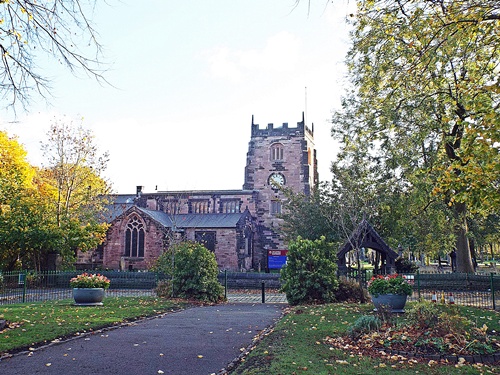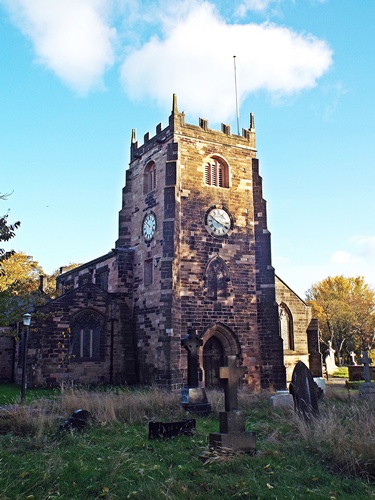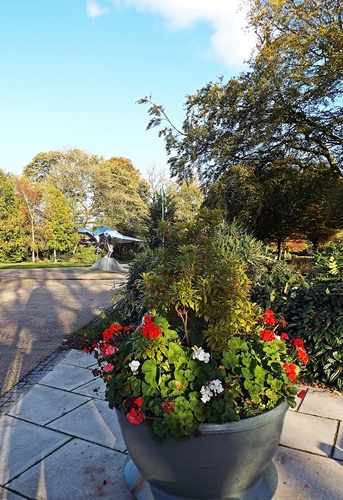My Monday walk this week is more of a wander than a walk and features a look round Radcliffe Tower and Close Park at Radcliffe, a town just over six miles from home. Being a frequent visitor to the large camping store in Radcliffe I’ve been to the town many times over the years but I didn’t know anything about Radcliffe Tower until just three days ago when I was reading through someone else’s blog. It seemed that the tower and park are in an area of the town which I’ve only ever passed through a couple of times on my way to somewhere else, which was probably why I didn’t know about it, so as there was plenty of sunshine and blue sky on Saturday afternoon I decided to take the dogs and check things out.
A 20-minute drive took me to the car park at the entrance to Close Park, and though I was itching to look round the park straight away I decided to find the tower first. Just off the main road and adjacent to the car park was Church Green, a three-sided cobbled lane with three modern terraced houses on one side, a small public garden in the middle and St. Mary’s church at the bottom end. Built in the 14th century with the tower being added in the 15th century the church is Grade l listed, with the churchyard containing the war graves of six soldiers from WW1 and three from WW2. Unfortunately the central garden and the front of the church itself were very much in the shade but I got a couple of photos then moved on to find the tower.

A path from the car park took me over a wide water-filled channel – originally a closed-off part of the nearby River Irwell – and past the back of the church to another path behind the far side of the graveyard ; the ruined tower and its surrounding land were completely enclosed by a high galvanised steel perimeter fence but at least there was a gate which allowed access during daylight hours.


Built as a typical fortified pele tower the earliest record of it dates back to 1358 ; it would have been three stories high with storage on the ground floor and living accommodation above. In 1403 the tower’s owner, James de Radcliffe, was given permission by King Henry IV to fortify his house and a new Great Hall was built to adjoin the tower, forming Radcliffe Manor, with the original ground floor storage area being converted into a kitchen with a fireplace on each of three walls. In 1517 the Manor passed to a distant branch of the Radcliffe family and in 1561 it was sold to the Assheton family who lived near Rochdale. They leased the hall and its land to tenant farmers, with subsequent members of the family continuing to do the same until 1765 when it was sold to the Earl of Wilton from Heaton Hall near Prestwich, though he continued to let it out to tenants.
By the early 1800s much of the Manor’s former grandeur had gone, with residents living only in the small west wing. The Great Hall was converted into a barn and the tower itself was used as a farm building, with the huge ground floor fireplaces in the south and east walls being knocked through to give access for farm carts and/or animals. By 1840 the Great Hall and the west wing were in such a state of disrepair that they were demolished and some of the stone from their foundations was used to build cottages nearby. The tower itself was spared and continued to be used as a farm building, with a new farmhouse being built to the north of where the Great Hall had been standing.
In 1925 the tower was scheduled as a monument and though it stayed in the ownership of the Wilton family until the 1950s the land round it wasn’t protected and in the 1940s gravel quarrying began to the south of the tower. By the 1960s the nearby farmhouse and cottages had been demolished, then starting in the 1970s the quarry was turned into a landfill site with large trucks rumbling right past the tower which, protected only by a fence round it, was in a very delapidated state by then. The future of the tower began to change in 1988 though when Bury Council took over ownership and conservation and stabilisation took place, which included blocking up two windows and the original fireplace arches. The scheduling of the monument was extended to include the land where the Great Hall had stood and by 2007 the landfill site had gone, with Bury Council acquiring the rest of the land surrounding the tower.
Starting in 2012 a series of archaeological investigations took place on the tower and Great Hall site and also on the site of the later farm and cottages which had been built nearby – finds from the Great Hall site included 15th century Cistercian drinking pots and storage jars and also showed that the floor would have been made from glazed tiles. Today the Medieval fabric of the tower has been professionally conserved and restored and the area round it has been landscaped, with a ‘pathway’ next to the tower marking out the footprint of the original Great Hall.






At various points around the grounds covered information boards told the history of the tower site and once I’d read and photographed them all I made my way through the gate and back along the path to the park. Close Park was originally the grounds to Close House, the home of the Bealey family who established a nearby bleaching business in the 18th century ; in 1925 the family presented the house to what was then Radcliffe Urban District Council for use as a Child Welfare Centre, with the grounds being converted into a public park for the town’s inhabitants. The house was also used as a clinic, a museum and an ambulance centre before being demolished in 1969, and the nearby bleachworks was finally demolished in the 1980s when a modern housing estate was built on the site. Current facilities and attractions at the park include 7 football pitches, 3 tennis courts, a bowling green, outdoor gym, children’s playground, a sensory garden and various sculptures which are part of the Irwell Sculpture Trail.
Starting from the car park the first thing I saw was a huge stainless steel dinosaur, one of three sculptures created by artist Mark Jalland in consultation with children from local primary schools. From there I followed the path down to the sensory garden and what I first thought was a water feature was actually a stainless steel and copper sculpture based on a cup cake, although after seeing it on an internet picture it seemed to have lost its chocolate topping. The third sculpture, not far from the bowling green, was a cheetah wearing trainers – presumably meant to signify running fast but strangely the trainers were only on diagonal feet. Who knows what goes on in the minds of these artists?!
















It’s such a shame the tower went into such a sorry state of repair until it was saved relatively recently. Thinking about “Tara” wearing only two trainers perhaps it signifies we only need two feet to run fast, what do you think? What you say about all this information being at our fingertips and just a few clicks away is so true. I used to trawl through books from the library and now I am discovering so much I didn’t know about the places where my ancestors lived and worked, it’s so fascinating. All you need is an inquiring mind.
LikeLike
Reading the full history of the tower and other buildings going back centuries it seems strange to me that the 1960s and 70s are part of that history – I can remember right back to my early childhood and growing up through the 60s and into the early 70s, and it just doesn’t seem like history to me as it’s happened in my own lifetime, especially as the land was only completely saved just 11 years ago. As you say, it’s a shame that the tower had got so bad before it was saved – I would have loved to see it when it was more complete.
As for ‘Tara’ wearing only two trainers you may be right in your thinking but then there could be any reasoning behind it – maybe it’s up to each individual to interpret it how they want. Although just to be pedantic, there are no laces in the trainers so how could she run like that, they would fall of her feet 🙂 🙂
LikeLike
Wow! What a great find Eunice. And I love the sculptures. The internet can definitely be a wonderful thing. 🙂 X
LikeLike
It was a great discovery thanks to the internet. My favourite sculpture is the cheetah, I’ve always loved cheetahs and even more so since getting up close and personal with some on a couple of occasions several years ago 🙂
LikeLike
fascinating post and lovely autumnal pictures.
LikeLike
Thank you. There was a very cold wind blowing on Saturday but the sunshine and blue sky were just too good to miss, and having just found out about the tower and the park it was a good opportunity for a few photos. I’ve been out again today taking photos for next Monday’s post, I haven’t got them on the pc yet but hopefully there should be some nice ones 🙂
LikeLike
Wowza, that is an amazing park full of history and color! What a find, Eunice.
LikeLike
And all thanks to the internet! It’s amazing to think that this place is only a few miles and a short drive from home in a town I’ve been to often yet I didn’t know it was there until a few days ago. The history of the place, especially the tower, is fascinating and the park is certainly worth going to again 🙂
LikeLike
It looks a pleasant place for a stroll, Eunice. The tower is lovely. 🙂 🙂
LikeLike
It’s a shame the tower got so ruined before being saved, I would have loved to see it looking more complete. The park is lovely for a wander round, I can imagine it will be nice in spring so I must remember to go back then 🙂
LikeLike